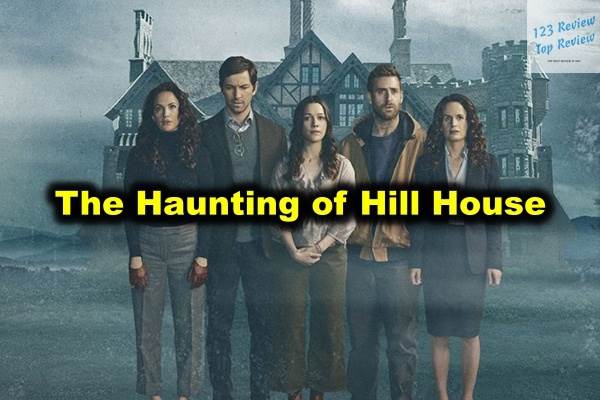The Haunting of Hill House, penned by Shirley Jackson in 1959, the novel is not only a seminal piece of Gothic horror but also a profound exploration of psychological torment, trauma, and the human condition.
In this article, 123 Review delves deeply into the key themes, motifs, characters, and symbolism that make The Haunting of Hill House a masterpiece. Additionally, it examines the various adaptations and their interpretations, the psychological aspects underlying the horror, and the historical context that shaped this extraordinary narrative.
Key Themes and Motifs
The Concept of Trauma
Trauma is a central theme in The Haunting of Hill House, intricately woven into the fabric of the story and the characters’ lives. Hill House itself can be seen as a living embodiment of the characters’ unresolved traumas, particularly that of Eleanor Vance, who is haunted by the lingering effects of her past. Her history of caring for an oppressive, sickly mother left Eleanor with deep psychological scars, which the house exploits. The trauma manifests not only through Eleanor’s interactions with the house but also in her relationships with other characters, where her insecurities and fears surface repeatedly.

The novel explores how trauma can distort perception, leading to a breakdown of reality. Eleanor’s fragile mental state makes her susceptible to the house’s influence, causing her to interpret its supernatural occurrences as a reflection of her inner turmoil. The house, in essence, becomes a mirror to Eleanor’s soul, exposing the vulnerabilities she has tried to bury. This exploration of trauma is not limited to Eleanor; other characters, such as Theodora, also grapple with their own emotional wounds, which the house preys upon.
The Role of Memory
Memory plays a pivotal role in The Haunting of Hill House, blurring the lines between past and present, reality and illusion. For Eleanor, memories of her troubled past—particularly her relationship with her mother—are inescapable, and these memories feed into the house’s malevolent power. The house seems to possess a consciousness that can manipulate the memories of its inhabitants, turning their recollections into instruments of psychological torture.
The novel suggests that memory is not a static or reliable construct but a fluid, malleable entity that can be influenced by external forces. In Hill House, memory becomes a weapon, used by the house to deepen the characters’ fears and anxieties. Eleanor’s memories, for example, are constantly reshaped by her experiences in the house, making her increasingly uncertain of what is real and what is imagined. This motif of memory manipulation adds to the overall sense of unease and horror, as the characters—and readers—are left questioning the reliability of their perceptions.
Isolation and Its Effects
Isolation is a recurring motif in The Haunting of Hill House, both in the physical setting and in the emotional experiences of the characters. The house itself is situated far from civilization, a sprawling, oppressive structure that seems to exist in its own world, cut off from reality. This physical isolation is mirrored in the characters’ emotional states, particularly Eleanor, who is depicted as a deeply lonely individual, disconnected from those around her.
Eleanor’s isolation is both self-imposed and externally reinforced by the house. Her desire for companionship and belonging is palpable, yet her inability to connect with others drives her further into the house’s grasp. The house amplifies her isolation, creating an environment where she is left alone with her fears, leading to a slow descent into madness. The novel uses this isolation to explore the effects of loneliness on the human psyche, suggesting that the true horror lies not in the supernatural but in the alienation and disconnection that the characters experience.
The Influence of Family Dynamics
Family dynamics play a crucial role in shaping the characters’ experiences and interactions with Hill House. The Crain family, who originally owned the house, is depicted as having a tragic and tumultuous history, filled with death, despair, and unresolved conflicts. This history leaves a lingering influence on the house itself, which seems to absorb and reflect the negative energy of its past inhabitants.
Eleanor’s relationship with her own family is similarly fraught with tension and unresolved emotions. Her role as her mother’s caretaker left her feeling trapped and unfulfilled, and these feelings of inadequacy and resentment make her more vulnerable to the house’s influence. The novel suggests that the house serves as a physical manifestation of the characters’ unresolved familial issues, trapping them in a cycle of fear and despair that mirrors the dysfunction of their family relationships.
Character Analysis
Eleanor Vance’s Journey
Eleanor Vance is the heart and soul of The Haunting of Hill House, and her journey is one of profound psychological unraveling. From the moment she arrives at Hill House, it is clear that Eleanor is a deeply troubled individual, burdened by years of caregiving and a sense of inadequacy. Her desire to escape her past and find a place where she belongs makes her particularly susceptible to the house’s influence.
As the story progresses, Eleanor’s grip on reality weakens, and she becomes increasingly obsessed with the house. Her interactions with the other characters reveal her deep-seated insecurities and her desperate need for validation and acceptance. However, the more she tries to connect with others, the more isolated she becomes, until she is completely consumed by the house.
Eleanor’s tragic end is the culmination of her psychological decline, as she ultimately surrenders to the house’s power. Her journey is a poignant exploration of the effects of trauma, loneliness, and the search for identity, making her one of the most complex and compelling characters in horror literature.
The Crain Family Dynamics
The Crain family’s history with Hill House is integral to the story’s tension and the house’s malevolent presence. Hugh Crain, the original owner, built the house with the intention of creating a grand, enduring legacy, but the house instead became a site of tragedy and death. The deaths of his wives, the isolation of his children, and the eventual demise of his family left a dark stain on the house, one that seems to infect everyone who enters it.
The Crain family’s story is one of unresolved grief, anger, and loss, and these emotions are deeply embedded in the house’s walls. The house acts as a vessel for the family’s unresolved conflicts, perpetuating the cycle of trauma for those who enter it. The Crain family dynamics serve as a reflection of the novel’s broader themes of trauma and memory, highlighting the inescapable influence of the past on the present.
The Impact of Dr. John Montague
Dr. John Montague is the catalyst for the events in The Haunting of Hill House, as he invites a group of people to investigate the house’s paranormal activity. A scholar of the occult, Montague is portrayed as a rationalist who believes that scientific observation can explain the supernatural occurrences at Hill House. However, his presence in the house sets the stage for the unfolding horror, as his experiments inadvertently provoke the house’s malevolent forces.
Montague’s role in the story is that of an observer and facilitator, yet his inability to control the situation reflects the limitations of science and reason when confronted with the unknown. His character serves as a counterpoint to the more emotionally driven characters, highlighting the tension between logic and the supernatural. Despite his scholarly approach, Montague is ultimately powerless to protect his companions from the house’s influence, underscoring the novel’s theme of the unknowable nature of fear.
The Women of Hill House
The women in The Haunting of Hill House—Eleanor, Theodora, and Mrs. Montague—each represent different aspects of femininity and psychological vulnerability. Eleanor, as previously discussed, embodies fragility and the search for identity, while Theodora is portrayed as confident, independent, and emotionally resilient. The contrast between Eleanor and Theodora highlights the different ways women navigate their psychological landscapes, with Theodora’s strength serving as a foil to Eleanor’s vulnerability.
Mrs. Montague, the wife of Dr. Montague, is another important female figure in the novel. Her no-nonsense approach to the supernatural provides a counterpoint to the more subtle, psychological horror experienced by the other characters. Unlike the others, Mrs. Montague is dismissive of the house’s power, relying instead on spiritualism and ritual to protect herself. Her character adds a layer of complexity to the narrative, exploring the different ways women confront and cope with fear.
Together, these women’s experiences add depth to the story, highlighting themes of identity, power, and vulnerability. Their interactions with Hill House reveal the various ways in which fear and trauma manifest, making them central to the novel’s exploration of psychological horror.
Symbolism in Hill House
The House as a Living Entity
Hill House itself is more than just a setting; it is a character in its own right, described in terms that suggest it is alive. The house’s architecture is deliberately unsettling, with its bizarre angles, disorienting corridors, and oppressive atmosphere creating a sense of unease from the moment Eleanor arrives. Jackson’s description of the house emphasizes its malevolent presence, suggesting that it has a consciousness that actively seeks to harm those who enter it.
The house’s design, with its labyrinthine layout and hidden rooms, reflects the psychological maze that the characters must navigate. It is as if the house is a living entity, feeding off the emotions and fears of its inhabitants. This symbolism is central to the novel’s horror, as it suggests that the true danger lies not in the house itself, but in its ability to manipulate and distort reality.
The idea of the house as a living entity also ties into the novel’s broader themes of trauma and memory. Just as the characters are haunted by their pasts, the house is haunted by the legacy of its previous inhabitants, particularly the Crain family. The house’s malevolent influence is a physical manifestation of the unresolved traumas and conflicts that continue to plague those who enter it.
Mirrors and Reflections
Mirrors and reflections play a significant symbolic role in The Haunting of Hill House, representing the characters’ inner selves and the distortions of reality. Throughout the novel, mirrors are used to create a sense of disorientation and to blur the line between the real and the imagined. For Eleanor, mirrors become a source of anxiety, as they reflect not only her physical appearance but also her inner turmoil.
The use of mirrors also ties into the theme of memory, as reflections can be seen as distorted versions of reality, much like the characters’ memories are manipulated by the house. The mirrors in Hill House serve as a metaphor for the characters’ fragmented psyches, reflecting their fears and insecurities back at them. This symbolism adds to the overall atmosphere of horror, as the characters are constantly confronted with distorted versions of themselves.
The Use of Color and Lighting
Color and lighting are used strategically in The Haunting of Hill House to enhance the novel’s atmosphere and to symbolize the characters’ emotional states. The house is described in dark, oppressive tones, with shadowy corners and dimly lit rooms creating a sense of foreboding. The lack of natural light in the house adds to the sense of isolation and claustrophobia, trapping the characters in a world of darkness.
The use of color also plays a symbolic role in the novel. For example, the red room, where Eleanor spends much of her time, is associated with danger and psychological distress. The vibrant color contrasts with the dull, muted tones of the rest of the house, drawing attention to Eleanor’s growing obsession with the house and her descent into madness. The red room becomes a focal point for the novel’s themes of fear and anxiety, serving as a visual representation of Eleanor’s inner turmoil.
Shadows and Darkness
Shadows and darkness are pervasive elements in The Haunting of Hill House, symbolizing the unknown and the characters’ deepest fears. The house is filled with dark corners and shadowy hallways, creating an environment where the characters are never quite sure of what they are seeing. This ambiguity adds to the novel’s psychological horror, as the characters—and readers—are left to wonder whether the shadows are real or a product of their imaginations.
Darkness in the novel also represents the characters’ emotional and psychological states. As they become more isolated and consumed by the house, they are increasingly enveloped in darkness, both literally and metaphorically. The novel uses darkness to explore themes of fear, loss of control, and the unknown, suggesting that the true horror lies not in the house itself, but in the darkness within the characters’ minds.
Adaptations and Interpretations
Comparison with the Original Novel
The various adaptations of The Haunting of Hill House have taken different approaches to the source material, each interpreting the novel’s themes and characters in unique ways. The 1963 film adaptation, directed by Robert Wise, is widely regarded as one of the most faithful to Jackson’s novel, capturing the psychological horror and ambiguity that make the book so compelling. The film focuses on Eleanor’s psychological decline, using camera angles and sound design to create a sense of unease and disorientation that mirrors the novel’s atmosphere.
In contrast, the 1999 film adaptation directed by Jan de Bont took a more overtly supernatural approach, emphasizing special effects and visual spectacle over psychological tension. This version was less well-received by critics, as it deviated significantly from the novel’s subtle, character-driven horror.
The Netflix series adaptation, created by Mike Flanagan in 2018, offers a more modern and innovative take on the story. While the series diverges from the original plot, it remains true to the novel’s themes, exploring trauma, family dynamics, and the nature of fear in a contemporary context. The series expands on the Crain family’s backstory, giving each character more depth and exploring the long-term effects of their experiences in Hill House. This adaptation has been praised for its ability to capture the essence of Jackson’s novel while also offering fresh insights and interpretations.
The 1963 Film Adaptation
The 1963 film adaptation of The Haunting of Hill House, simply titled The Haunting, is considered a classic of the horror genre. Directed by Robert Wise, the film is known for its use of psychological horror and its faithful adaptation of the novel’s themes. Wise’s direction emphasizes the ambiguity of the supernatural events in the house, leaving it unclear whether the occurrences are real or a product of Eleanor’s deteriorating mind.
The film’s cinematography and sound design play a crucial role in creating an atmosphere of tension and unease. The use of wide-angle lenses, distorted perspectives, and eerie sound effects enhances the sense of disorientation and claustrophobia, mirroring the novel’s exploration of psychological terror. The Haunting is widely regarded as one of the best horror films of its era and remains a significant influence on the genre.
Netflix Series: Innovations and Divergences
The Netflix series The Haunting of Hill House, released in 2018, took a bold approach to adapting Shirley Jackson’s novel. While it retained the title and some of the key elements of the story, the series diverged significantly from the original plot, introducing new characters, subplots, and themes. This adaptation reimagined the Crain family as the central focus, exploring their experiences in Hill House both in the past and present.
One of the most significant innovations in the Netflix series is its non-linear narrative structure, which weaves together different timelines to reveal the full story of the Crain family. This approach allows the series to delve deeper into the psychological and emotional impact of the events in Hill House, offering a more comprehensive exploration of trauma and its lasting effects. The series also introduced new supernatural elements and expanded on the house’s backstory, creating a more complex and layered narrative.
While some purists may have been disappointed by the series’ deviations from the novel, many critics and viewers praised it for its fresh perspective and its ability to capture the spirit of Jackson’s work. The series successfully blends psychological horror with modern storytelling techniques, making it a standout adaptation in its own right.
Influence on Modern Horror Media
The Haunting of Hill House has had a lasting impact on the horror genre, influencing both literature and film. Its exploration of psychological horror, trauma, and the ambiguity of the supernatural has inspired countless works in the genre. The novel’s focus on character-driven horror, where the true terror comes from within, has become a staple of modern horror storytelling.
The influence of The Haunting of Hill House can be seen in films such as The Shining (1980) and Hereditary (2018), both of which explore themes of family dynamics, trauma, and psychological decline. The novel’s impact is also evident in television series like American Horror Story, which often incorporates elements of Gothic horror and psychological tension.
The Netflix adaptation, in particular, has sparked a renewed interest in Shirley Jackson’s work and the Gothic horror genre as a whole. Its success has led to a resurgence of interest in character-driven horror, where the focus is on the emotional and psychological experiences of the characters rather than on jump scares or gore. This shift in focus has helped to elevate the horror genre, allowing for more nuanced and sophisticated storytelling.
Psychological Aspects
Fear and Anxiety Manifestations
The Haunting of Hill House is a masterclass in the portrayal of fear and anxiety, using subtle psychological techniques to create an atmosphere of constant dread. The novel delves into the ways in which fear manifests in the mind, often taking the form of irrational thoughts, paranoia, and a breakdown of reality. Eleanor’s experiences in Hill House are a vivid portrayal of this psychological terror, as her anxieties and insecurities are amplified by the house’s influence.
Jackson’s use of language and imagery heightens the sense of fear, often leaving the reader unsure of what is real and what is imagined. This ambiguity is a key aspect of the novel’s horror, as it forces the reader to confront their own fears and uncertainties. The novel suggests that the true horror lies not in the supernatural, but in the characters’ minds, where fear and anxiety take on a life of their own.
The Role of the Uncanny
The concept of the uncanny is central to the horror in The Haunting of Hill House. The uncanny, as defined by Sigmund Freud, refers to something that is both familiar and strange, creating a sense of unease and discomfort. In the novel, Hill House itself embodies the uncanny, with its familiar elements—a house, furniture, family heirlooms—twisted into something unsettling and terrifying.
The novel’s exploration of the uncanny is evident in the way it blurs the lines between the real and the supernatural, the known and the unknown. The house’s architecture, with its distorted angles and disorienting layout, creates a sense of unease that permeates the entire story. The characters’ experiences in the house are similarly uncanny, as they encounter familiar objects and sounds that have taken on a sinister quality.
The use of the uncanny in The Haunting of Hill House enhances the novel’s psychological horror, as it taps into deep-seated fears of the unknown and the loss of control. The novel’s ability to evoke the uncanny is one of the reasons it remains such an effective and enduring work of horror.
Mental Illness Representation
Mental illness is a significant theme in The Haunting of Hill House, particularly in the character of Eleanor. Throughout the novel, Eleanor’s mental state is portrayed as fragile and unstable, with her experiences in Hill House exacerbating her existing psychological issues. The novel’s portrayal of mental illness is nuanced, exploring the ways in which trauma, loneliness, and fear can contribute to a person’s psychological decline.
Eleanor’s descent into madness is depicted with sensitivity and complexity, avoiding the stigmatizing tropes often associated with mental illness in horror. Jackson portrays Eleanor’s experiences as deeply human, driven by her past traumas and her longing for connection. This portrayal adds depth to the novel’s horror, as it suggests that the true terror lies not in the supernatural, but in the fragility of the human mind.
The novel’s exploration of mental illness is also reflected in its treatment of the other characters, who each grapple with their own emotional and psychological struggles. The house acts as a catalyst for these issues, bringing them to the surface and forcing the characters to confront their own fears and insecurities. This exploration of mental illness adds a layer of psychological depth to the novel, making it a rich and multifaceted work of horror.
Historical Context
Post-World War II Anxiety
The Haunting of Hill House was published in 1959, a time when the world was grappling with the aftermath of World War II and the onset of the Cold War. The novel reflects the anxieties of this era, particularly the fear of the unknown and the sense of impending doom. The house itself can be seen as a metaphor for the uncertainty and instability of the post-war world, with its disorienting architecture and malevolent presence reflecting the anxieties of the time.
The novel’s exploration of trauma and memory can also be linked to the broader context of post-war society, where individuals were struggling to come to terms with the horrors of the recent past. The characters’ experiences in Hill House can be seen as a reflection of the collective trauma of the era, with the house serving as a symbol of the unresolved conflicts and fears that lingered in the aftermath of the war.
Shirley Jackson’s Personal Influences
Shirley Jackson’s personal experiences and beliefs heavily influenced The Haunting of Hill House. Jackson was known for her interest in the occult and the supernatural, and these themes are evident throughout the novel. Her own struggles with mental illness and her complex relationship with her family also informed her portrayal of the characters and their experiences in Hill House.
Jackson’s exploration of female identity and the roles of women in society is another key aspect of the novel, reflecting her own experiences as a woman in mid-20th-century America. The characters of Eleanor and Theodora, in particular, can be seen as representations of the conflicting expectations placed on women at the time, with their struggles for identity and autonomy mirroring Jackson’s own.
The novel’s setting and atmosphere were also influenced by Jackson’s experiences living in various old, isolated houses, which she often described as having a life of their own. This sense of a house as a living entity is central to the horror of The Haunting of Hill House, making it one of the most memorable and influential works in the genre.
Conclusion
The Haunting of Hill House remains a cornerstone of horror literature, a masterpiece that continues to captivate and terrify readers and viewers alike. Shirley Jackson’s exploration of trauma, memory, isolation, and the uncanny, combined with her rich character development and psychological depth, has cemented the novel’s place as a classic of the genre. The various adaptations of the story, each bringing its own interpretation and innovations, have only furthered its influence, ensuring that the legacy of Hill House endures in popular culture. Whether through the written word or on screen, The Haunting of Hill House continues to haunt us, a testament to the enduring power of fear, both real and imagined.





